Enhanced Stability of Vegetal Diamine Oxidase with Trehalose and Sucrose as Cryoprotectants: Mechanistic Insights
Abstract
:1. Introduction
2. Results and Discussion
2.1. vDAO Activity after Lyophilization
2.2. Thermal Properties of the Freeze-Dried Formulations
2.3. Characterization of vDAO Powders
2.4. vDAO Activity after Long-Term Storage at Different Temperatures
2.5. Behavior of the Enzyme Formulations in Tablet Forms
2.5.1. Stability of vDAO in the Dry Tablets
2.5.2. In Vitro Dissolution Tests
2.5.3. Commercial products
3. Materials and Methods
3.1. Materials
3.2. Preparation of Enzyme Formulation and Lyophilization
3.3. vDAO Activity Measuring
- Specific activity: DCHBS-AAP-HRP method
- 2.
- Protein quantification
3.4. Scanning Electron Microscopy (SEM)
3.5. Thermogravimetric Analysis (TGA)
3.6. DSC (Differential Scanning Calorimetry) Measurements
3.7. Preparation of Monolithic Tablets
3.7.1. Characterization of Dry Tablets
3.7.2. In Vitro Dissolution Tests
3.8. Statistical Analysis
4. Conclusions
Supplementary Materials
Author Contributions
Funding
Institutional Review Board Statement
Informed Consent Statement
Data Availability Statement
Acknowledgments
Conflicts of Interest
Abbreviations
References
- Potts, R.A.; Tiffany, C.M.; Pakpour, N.; Lokken, K.L.; Tiffany, C.R.; Cheung, K.; Tsolis, R.M.; Luckhart, S. Mast cells and histamine alter intestinal permeability during malaria parasite infection. Immunobiology 2016, 221, 468–474. [Google Scholar] [CrossRef] [PubMed] [Green Version]
- Enwonwu, C.O.; Afolabi, B.M.; Salako, L.O.; Idigbe, E.O.; Bashirelahi, N. Increased plasma levels of histidine and histamine in falciparum malaria: Relevance to severity of infection. J. Neural Transm. 2000, 107, 1273–1287. [Google Scholar] [CrossRef] [PubMed]
- Hodges, P.; Kelly, P. Inflammatory bowel disease in Africa: What is the current state of knowledge? Int. Health 2020, 12, 222–230. [Google Scholar] [CrossRef] [PubMed] [Green Version]
- Smolinska, S.; Winiarska, E.; Globinska, A.; Jutel, M. Histamine: A Mediator of Intestinal Disorders—A Review. Metabolites 2022, 12, 895. [Google Scholar] [CrossRef]
- Pugin, B.; Barcik, W.; Westermann, P.; Heider, A.; Wawrzyniak, M.; Hellings, P.; Akdis, C.A.; O’Mahony, L. A wide diversity of bacteria from the human gut produces and degrades biogenic amines. Microb. Ecol. Health Dis. 2017, 28, 1353881. [Google Scholar] [CrossRef]
- Sánchez-Pérez, S.; Comas-Basté, O.; Duelo, A.; Veciana-Nogués, M.T.; Berlanga, M.; Latorre-Moratalla, M.L.; Vidal-Carou, M.C. Intestinal Dysbiosis in Patients with Histamine Intolerance. Nutrients 2022, 14, 1774. [Google Scholar] [CrossRef] [PubMed]
- Bodmer, S.; Imark, C.; Kneubühl, M. Biogenic amines in foods: Histamine and food processing. Inflamm. Res. 1999, 48, 296–300. [Google Scholar] [CrossRef]
- Landete, J.M.; Ferrer, S.; Polo, L.; Pardo, I. Biogenic Amines in Wines from Three Spanish Regions. J. Agric. Food Chem. 2005, 53, 1119–1124. [Google Scholar] [CrossRef]
- Lavizzari, T.; Veciana-Nogués, M.T.; Weingart, O.; Bover-Cid, S.; Mariné-Font, A.; Vidal-Carou, M.C. Occurrence of Biogenic Amines and Polyamines in Spinach and Changes during Storage under Refrigeration. J. Agric. Food Chem. 2007, 55, 9514–9519. [Google Scholar] [CrossRef]
- Benly, P. Role of histamine in acute inflammation. J. Pharm. Sci. Res. 2015, 7, 373–376. [Google Scholar]
- Calinescu, C.; Mondovi, B.; Federico, R.; Ispas-Szabo, P.; Mateescu, M.A. Carboxymethyl starch: Chitosan monolithic matrices containing diamine oxidase and catalase for intestinal delivery. Int. J. Pharm. 2012, 428, 48–56. [Google Scholar] [CrossRef] [PubMed]
- Jumarie, C.; Séïde, M.; Marcocci, L.; Pietrangeli, P.; Mateescu, M.A. Diamine Oxidase from White Pea (Lathyrus sativus) Combined with Catalase Protects the Human Intestinal Caco-2 Cell Line from Histamine Damage. Appl. Biochem. Biotechnol. 2017, 182, 1171–1181. [Google Scholar] [CrossRef] [PubMed] [Green Version]
- Mateescu, M.A.; Koudoufio, M.D.; Tchoumi Neree, A.; Mondovì, B. Plant Histaminase as Bioactive Agent to Lower the Histamine Level: A Mini-Review. J. Gastroenterol. Res. 2017, 1, 34–41. [Google Scholar] [CrossRef]
- Brazeau, B.J.; Johnson, B.J.; Wilmot, C.M. Copper-containing amine oxidases. Biogenesis and catalysis; a structural perspective. Arch. Biochem. Biophys. 2004, 428, 22–31. [Google Scholar] [CrossRef] [PubMed]
- Boyce, S.; Tipton, K.F.; O’Sullivan, M.I.; Davey, G.P.; Gildea, M.M.; McDonald, A.G.; Olivieri, A.; O’Sullivan, J. Nomen-clature and potential functions of copper amine oxidases. In Copper Amine Oxidases; Floris, G., Mondovi, B., Eds.; CRC Press: Boca Raton, FL, USA, 2009; pp. 5–17. [Google Scholar]
- Mennigen, R.; Kusche, J.; Streffer, C.; Krakamp, B. Diamine oxidase activities in the large bowel mucosa of ulcerative colitis patients. Inflamm. Res. 1990, 30, 264–266. [Google Scholar] [CrossRef] [PubMed]
- Kumar, V.; Dooley, D.M.; Freeman, H.C.; Guss, M.; Harvey, I.; McGuirl, M.A.; Wilce, M.C.; Zubak, V.M. Crystal structure of a eukaryotic (pea seedling) copper-containing amine oxidase at 2.2 å resolution. Structure 1996, 4, 943–955. [Google Scholar] [CrossRef] [Green Version]
- Parsons, M.R.; Convery, M.; Wilmot, C.; Yadav, K.; Blakeley, V.; Corner, A.; Phillips, S.; McPherson, M.; Knowles, P. Crystal structure of a quinoenzyme: Copper amine oxidase of Escherichia coli at 2 å resolution. Structure 1995, 3, 1171–1184. [Google Scholar] [CrossRef] [Green Version]
- Hrubisko, M.; Danis, R.; Huorka, M.; Wawruch, M. Histamine Intolerance—The More We Know the Less We Know. A Review. Nutrients 2021, 13, 2228. [Google Scholar] [CrossRef] [PubMed]
- Befani, O.; Shiozaki, T.; Turini, P.; Gerosa, P.; Mondovi, B. Inhibition of Diamine Oxidase Activity by Metronidazole. Biochem. Biophys. Res. Commun. 1995, 212, 589–594. [Google Scholar] [CrossRef]
- Pietrangeli, P.; Federico, R.; Mondovì, B.; Morpurgo, L. Substrate specificity of copper-containing plant amine oxidases. J. Inorg. Biochem. 2007, 101, 997–1004. [Google Scholar] [CrossRef]
- Neree, A.T.; Pietrangeli, P.; Szabo, P.I.; Mateescu, M.A.; Marcocci, L. Stability of Vegetal Diamine Oxidase in Simulated Intestinal Media: Protective Role of Cholic Acids. J. Agric. Food Chem. 2018, 66, 12657–12665. [Google Scholar] [CrossRef] [PubMed]
- Schnedl, W.J.; Schenk, M.; Lackner, S.; Enko, D.; Mangge, H.; Forster, F. Diamine oxidase supplementation improves symptoms in patients with histamine intolerance. Food Sci. Biotechnol. 2019, 28, 1779–1784. [Google Scholar] [CrossRef] [PubMed] [Green Version]
- Butreddy, A.; Janga, K.Y.; Ajjarapu, S.; Sarabu, S.; Dudhipala, N. Instability of therapeutic proteins—An overview of stresses, stabilization mechanisms and analytical techniques involved in lyophilized proteins. Int. J. Biol. Macromol. 2021, 167, 309–325. [Google Scholar] [CrossRef] [PubMed]
- Chi, E.Y.; Krishnan, S.; Randolph, T.W.; Carpenter, J.F. Physical Stability of Proteins in Aqueous Solution: Mechanism and Driving Forces in Nonnative Protein Aggregation. Pharm. Res. 2003, 20, 1325–1336. [Google Scholar] [CrossRef]
- Fissore, D.; Pisano, R.; Barresi, A. The Freeze-Drying of Pharmaceutical Products; CRC Press: London, UK; New York, NY, USA, 2019; pp. 1–10. [Google Scholar]
- Kawai, K.; Suzuki, T. Stabilizing Effect of Four Types of Disaccharide on the Enzymatic Activity of Freeze-dried Lactate Dehydrogenase: Step by Step Evaluation from Freezing to Storage. Pharm. Res. 2007, 24, 1883–1890. [Google Scholar] [CrossRef]
- Mutukuri, T.T.; Wilson, N.E.; Taylor, L.S.; Topp, E.M.; Zhou, Q.T. Effects of drying method and excipient on the structure and physical stability of protein solids: Freeze drying vs. spray freeze drying. Int. J. Pharm. 2020, 594, 120169. [Google Scholar] [CrossRef]
- Arakawa, T.; Prestrelski, S.J.; Kenney, W.C.; Carpenter, J.F. Factors affecting short-term and long-term stabilities of proteins. Adv. Drug Deliv. Rev. 2001, 46, 307–326. [Google Scholar] [CrossRef]
- Chang, L.; Shepherd, D.; Sun, J.; Ouellette, D.; Grant, K.L.; Tang, X.; Pikal, M.J. Mechanism of protein stabilization by sugars during freeze-drying and storage: Native structure preservation, specific interaction, and/or immobilization in a glassy matrix? J. Pharm. Sci. 2005, 94, 1427–1444. [Google Scholar] [CrossRef]
- Izutsu, K.-I. Applications of Freezing and Freeze-Drying in Pharmaceutical Formulations. Adv. Exp. Med. Biol. 2018, 1081, 371–383. [Google Scholar] [CrossRef]
- Cicerone, M.T.; Pikal, M.J.; Qian, K.K. Stabilization of proteins in solid form. Adv. Drug Deliv. Rev. 2015, 93, 14–24. [Google Scholar] [CrossRef] [Green Version]
- Mensink, M.A.; Frijlink, H.W.; Van Der Voort Maarschalk, K.; Hinrichs, W.L.J. How sugars protect proteins in the solid state and during drying (review): Mechanisms of stabilization in relation to stress conditions. Eur. J. Pharm. Biopharm. 2017, 114, 288–295. [Google Scholar] [CrossRef] [PubMed]
- Wang, W. Lyophilization and development of solid protein pharmaceuticals. Int. J. Pharm. 2000, 203, 1–60. [Google Scholar] [CrossRef] [PubMed]
- Wang, B.; Tchessalov, S.; Cicerone, M.T.; Warne, N.W.; Pikal, M.J. Impact of sucrose level on storage stability of proteins in freeze-dried solids: II. Correlation of aggregation rate with protein structure and molecular mobility. J. Pharm. Sci. 2009, 98, 3145–3166. [Google Scholar] [CrossRef] [PubMed]
- Crowe, J.H.; Carpenter, J.F.; Crowe, L.M. The role of vitrification in anhydrobiosis. Annu. Rev. Physiol. 1998, 60, 73–103. [Google Scholar] [CrossRef]
- Grasmeijer, N.; Stankovic, M.; de Waard, H.; Frijlink, H.W.; Hinrichs, W. Unraveling protein stabilization mechanisms: Vitrification and water replacement in a glass transition temperature controlled system. Biochim. Biophys. Acta (BBA) Proteins Proteom. 2013, 1834, 763–769. [Google Scholar] [CrossRef]
- Starciuc, T.; Malfait, B.; Danede, F.; Paccou, L.; Guinet, Y.; Correia, N.T.; Hedoux, A. Trehalose or Sucrose: Which of the Two Should be Used for Stabilizing Proteins in the Solid State? A Dilemma Investigated by In Situ Micro-Raman and Dielectric Relaxation Spectroscopies During and After Freeze-Drying. J. Pharm. Sci. 2019, 109, 496–504. [Google Scholar] [CrossRef] [Green Version]
- Carpenter, J.F.; Chang, B.S.; Garzon-Rodriguez, W.; Randolph, T.W. Rational Design of Stable Lyophilized Protein Formulations: Theory and Practice. In Rational Design of Stable Protein Formulations: Theory and Practice; Carpenter, J.F., Manning, M.C., Eds.; Springer US: Boston, MA, USA, 2002; pp. 109–133. [Google Scholar]
- Tang, X.C.; Pikal, M.J. Design of Freeze-Drying Processes for Pharmaceuticals: Practical Advice. Pharm. Res. 2004, 21, 191–200. [Google Scholar] [CrossRef]
- Srirangsan, P.; Kawai, K.; Hamada-Sato, N.; Watanabe, M.; Suzuki, T. Improvement in the remaining activity of freeze-dried xanthine oxidase with the addition of a disaccharide–polymer mixture. Food Chem. 2010, 119, 209–213. [Google Scholar] [CrossRef] [Green Version]
- Nema, S.; Kenneth, E.A. Freeze-thaw studies of a model protein, lactate dehydrogenase, in the presence of cryoprotectants. PDA J. Pharm. Sci. Technol. 1993, 47, 76–83. [Google Scholar]
- Imamura, K.; Ogawa, T.; Sakiyama, T.; Nakanishi, K. Effects of Types of Sugar on the Stabilization of Protein in the Dried State. J. Pharm. Sci. 2003, 92, 266–274. [Google Scholar] [CrossRef]
- Wolkers, W.F.; Oldenhof, H. Cryopreservation and Freeze-Drying Protocols; Springer: Berlin/Heidelberg, Germany, 2015. [Google Scholar]
- Mu, D.; Medzihradszky, K.; Adams, G.; Mayer, P.; Hines, W.; Burlingame, A.; Smith, A.; Cai, D.; Klinman, J. Primary structures for a mammalian cellular and serum copper amine oxidase. J. Biol. Chem. 1994, 269, 9926–9932. [Google Scholar] [CrossRef] [PubMed]
- Duralliu, A.; Matejtschuk, P.; Williams, D.R. Measuring the specific surface area (SSA) of freeze-dried biologics using inverse gas chromatography. Eur. J. Pharm. Biopharm. 2019, 142, 216–221. [Google Scholar] [CrossRef] [PubMed]
- Franks, F. Long–term stabilization of biologicals. Biotechnology 1994, 12, 253–256. [Google Scholar] [CrossRef] [PubMed]
- Duralliu, A.; Matejtschuk, P.; Stickings, P.; Hassall, L.; Tierney, R.; Williams, D.R. The Influence of Moisture Content and Temperature on the Long-Term Storage Stability of Freeze-Dried High Concentration Immunoglobulin G (IgG). Pharmaceutics 2020, 12, 303. [Google Scholar] [CrossRef] [Green Version]
- Kasper, J.C.; Friess, W. The freezing step in lyophilization: Physico-chemical fundamentals, freezing methods and consequences on process performance and quality attributes of biopharmaceuticals. Eur. J. Pharm. Biopharm. 2011, 78, 248–263. [Google Scholar] [CrossRef]
- Chang, L.; Shepherd, D.; Sun, J.; Tang, X.; Pikal, M.J. Effect of sorbitol and residual moisture on the stability of lyophilized antibodies: Implications for the mechanism of protein stabilization in the solid state. J. Pharm. Sci. 2005, 94, 1445–1455. [Google Scholar] [CrossRef]
- Gutka, H. Rational selection of sugars for biotherapeutic stabilization: A Practitioner’s perspective. Bioprocess Int. 2018, 16, 40–44. [Google Scholar]
- Moosavi-Movahedi, A.A.; Amani, M.; Moosavi-Nejad, S.Z.; Hashemnia, S.; Ahmad, F.; Floris, G.; Mura, A.; Rezaei-Tavirani, M.; Hakimelahi, G.H.; Saboury, A.A.; et al. Thermal Dissection of Lentil Seedling Amine Oxidase Domains by Differential Scanning Calorimetry. Biosci. Biotechnol. Biochem. 2007, 71, 1644–1649. [Google Scholar] [CrossRef] [Green Version]
- Medda, R.; Padiglia, A.; Floris, G. Plant copper-amine oxidases. Phytochemistry 1995, 39, 1–9. [Google Scholar] [CrossRef]
- Chang, B.S.; Beauvais, R.M.; Dong, A.; Carpenter, J.F. Physical Factors Affecting the Storage Stability of Freeze-Dried Interleukin-1 Receptor Antagonist: Glass Transition and Protein Conformation. Arch. Biochem. Biophys. 1996, 331, 249–258. [Google Scholar] [CrossRef] [Green Version]
- Fonte, P.; Soares, S.; Costa, A.; Andrade, J.C.; Seabra, V.; Reis, S.; Sarmento, B. Effect of cryoprotectants on the porosity and stability of insulin-loaded PLGA nanoparticles after freeze-drying. Biomatter 2012, 2, 329–339. [Google Scholar] [CrossRef] [PubMed] [Green Version]
- Kounga, P.C.; Neree, A.T.; Pietrangeli, P.; Marcocci, L.; Mateescu, M.A. Faster and sensitive zymographic detection of oxidases generating hydrogen peroxide. The case of diamine oxidase. Anal. Biochem. 2022, 648, 114676. [Google Scholar] [CrossRef] [PubMed]
- Pietrangeli, P.; Bellelli, A.; Fattibene, P.; Mondovì, B.; Morpurgo, L. Lathyrus cicera copper amine oxidase reactions with tryptamine. J. Inorg. Biochem. 2012, 109, 33–39. [Google Scholar] [CrossRef] [PubMed]
- Bradford, M.M. A rapid and sensitive method for the quantitation of microgram quantities of protein utilizing the principle of protein-dye binding. Anal. Biochem. 1976, 72, 248–254. [Google Scholar] [CrossRef]
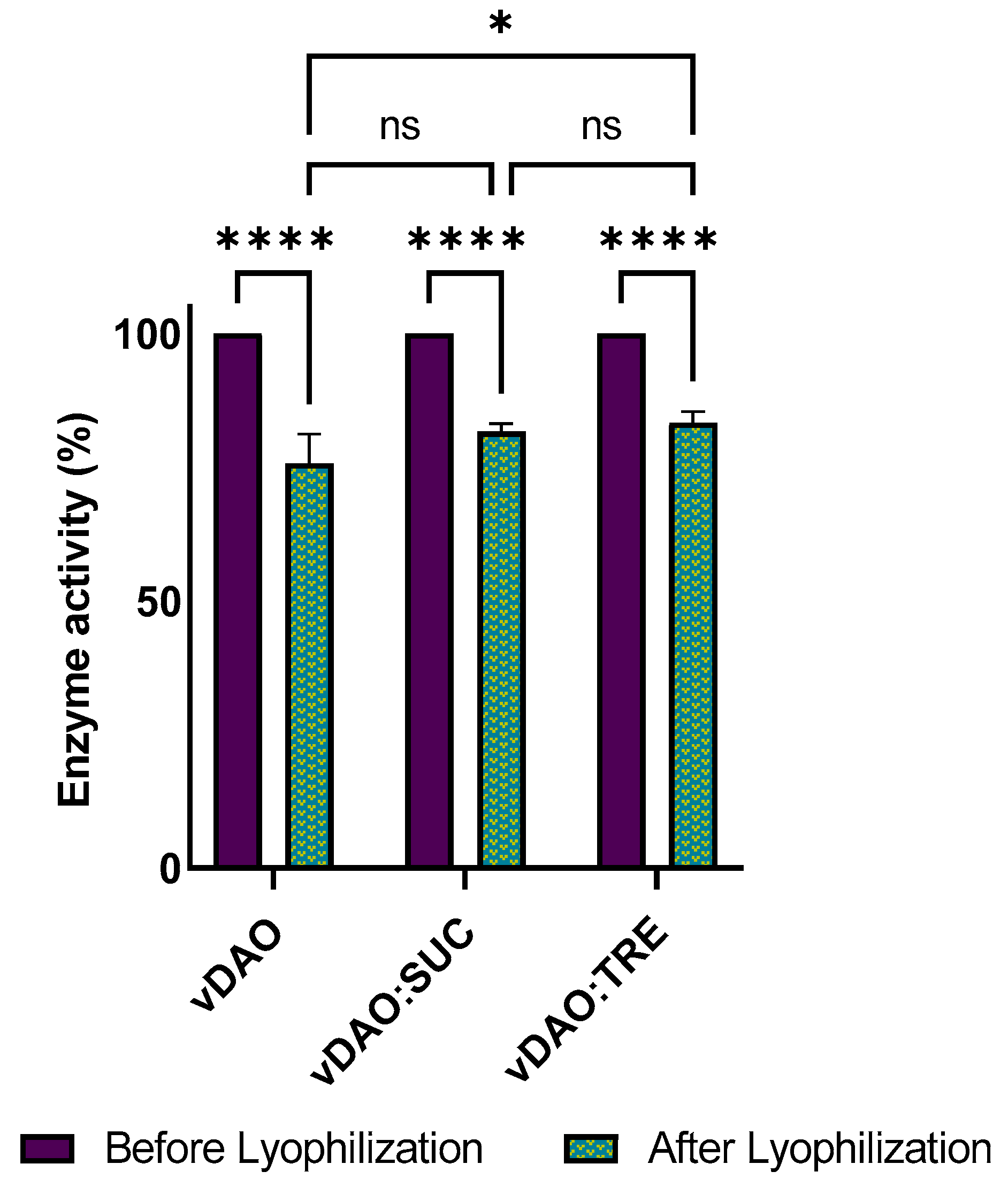


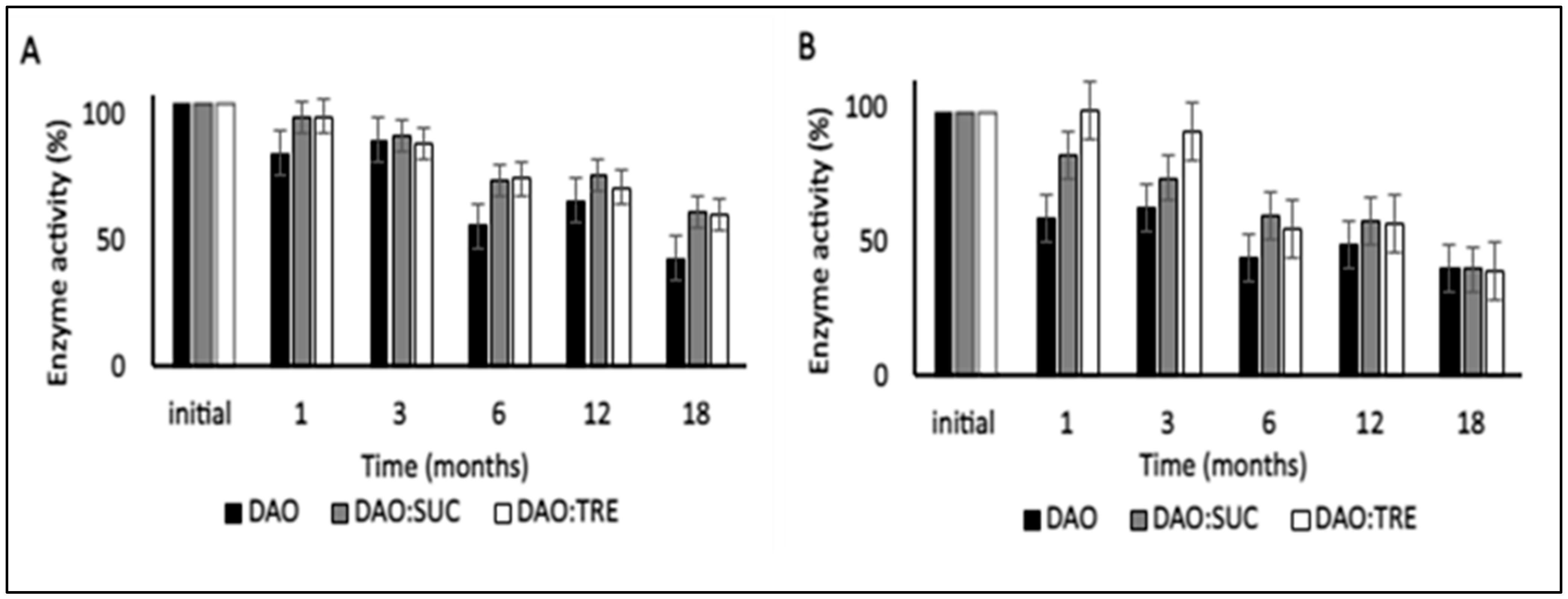
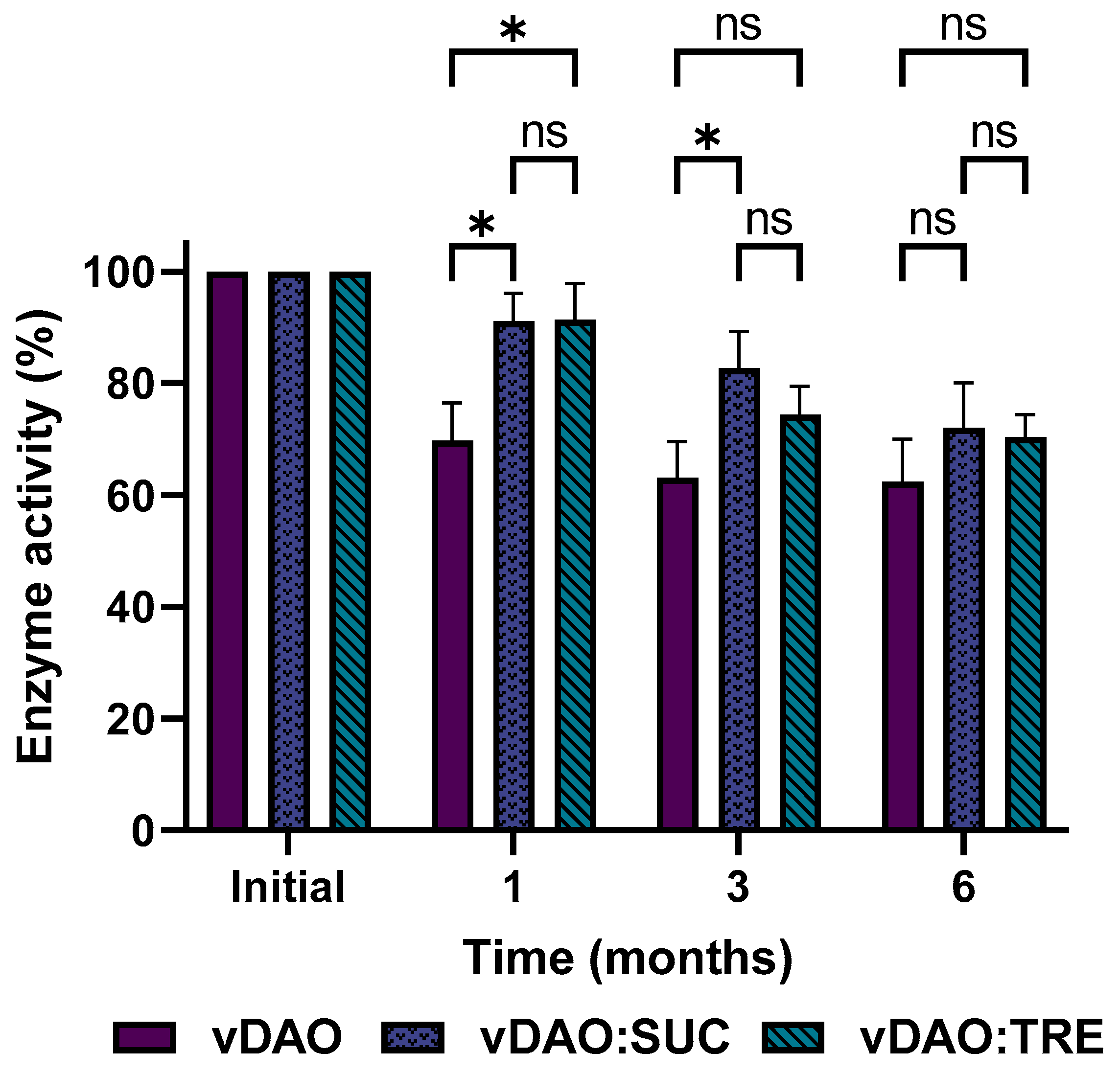
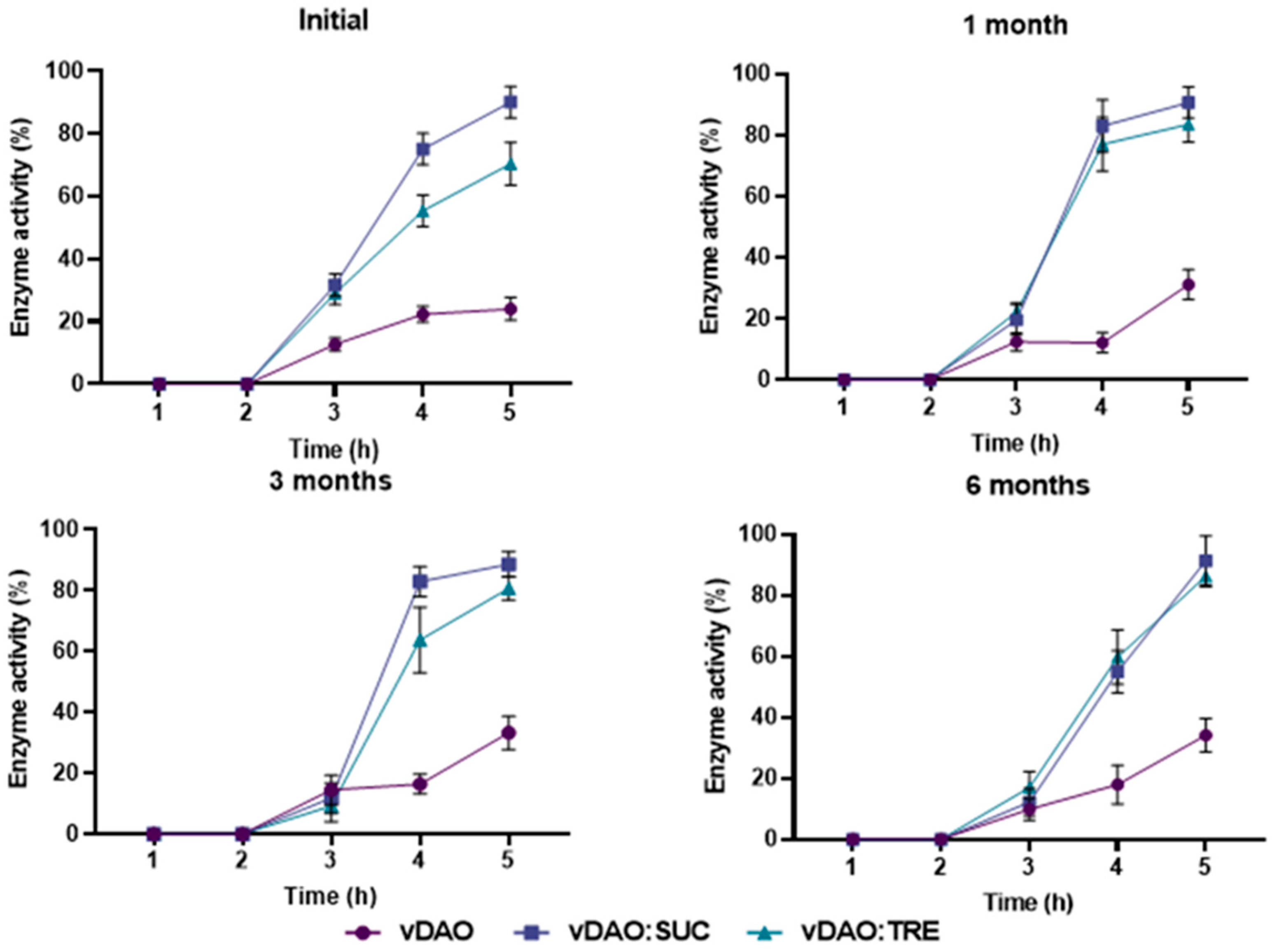
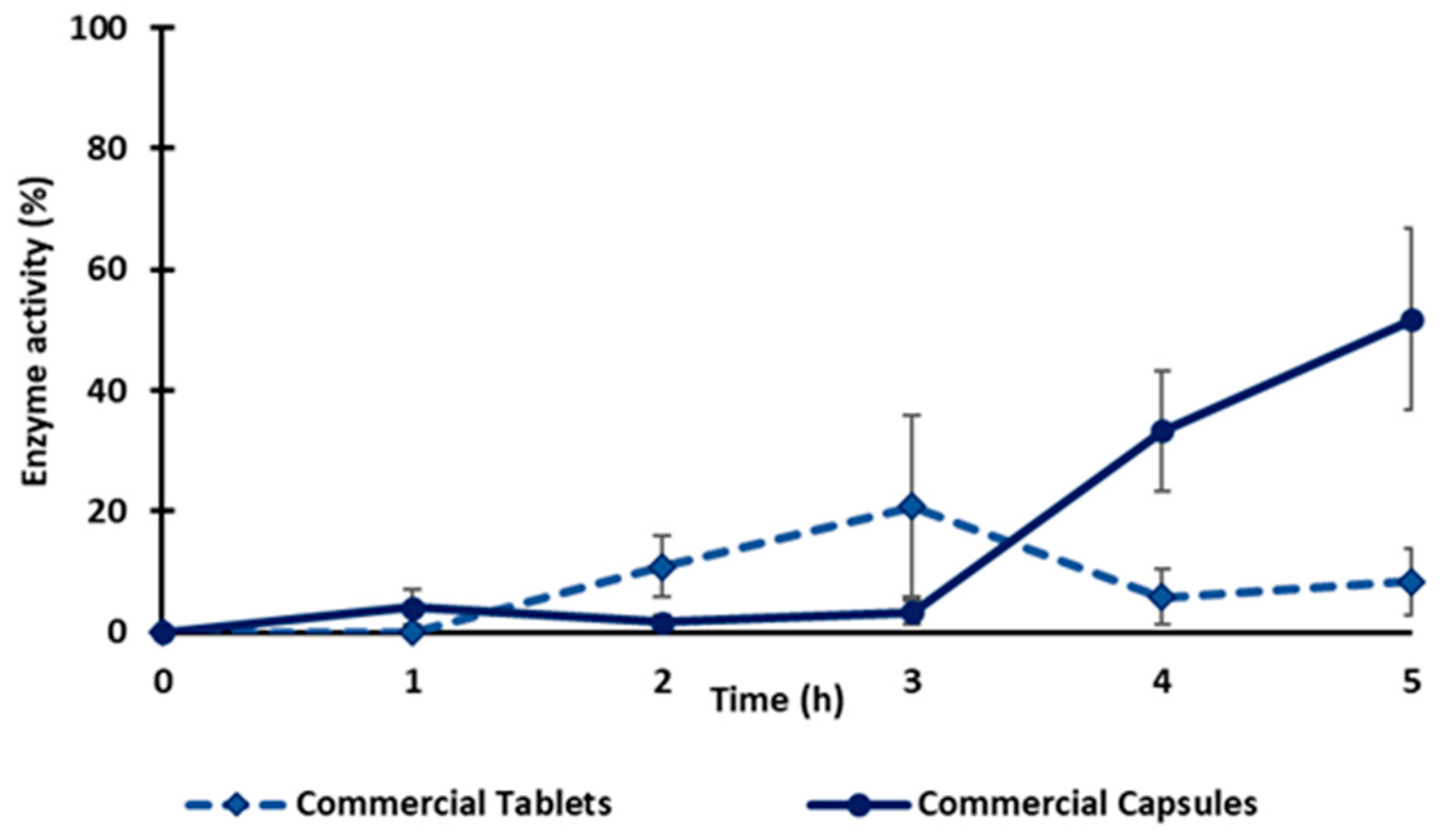
| Formulation | Tg (°C) 1 | Tc (°C) 1 | Residual Humidity 1 (%) |
|---|---|---|---|
| vDAO | 41.5 ± 7.7 | 152.1 ± 3.1 | 8.45 ± 0.82 |
| vDAO:SUC | 22.4 ± 3.1 | n/a | 3.27 ± 0.65 |
| vDAO:TRE | 34.9 ± 4.1 | n/a | 3.26 ± 0.71 |
| Formulation | Weight (mg) | Dimensions of Dry Tables | Hardness * (N) | Time for Complete Dissolution in SIF ** | |
|---|---|---|---|---|---|
| Diameter * (mm) | Thickness * (mm) | ||||
| vDAO | 300 | 9.60 ± 0.01 | 3.37 ± 0.03 | 12.03 ± 1.10 | 4–5 h |
| vDAO:Sucrose | 300 | 9.59 ± 0.01 | 3.37 ± 0.03 | 12.13 ± 0.50 | 4–5 h |
| vDAD:Trehalose | 300 | 9.61 ± 0.02 | 3.36 ± 0.03 | 9.53 ± 0.47 | 4–5 h |
Disclaimer/Publisher’s Note: The statements, opinions and data contained in all publications are solely those of the individual author(s) and contributor(s) and not of MDPI and/or the editor(s). MDPI and/or the editor(s) disclaim responsibility for any injury to people or property resulting from any ideas, methods, instructions or products referred to in the content. |
© 2023 by the authors. Licensee MDPI, Basel, Switzerland. This article is an open access article distributed under the terms and conditions of the Creative Commons Attribution (CC BY) license (https://creativecommons.org/licenses/by/4.0/).
Share and Cite
Megoura, M.; Ispas-Szabo, P.; Mateescu, M.A. Enhanced Stability of Vegetal Diamine Oxidase with Trehalose and Sucrose as Cryoprotectants: Mechanistic Insights. Molecules 2023, 28, 992. https://doi.org/10.3390/molecules28030992
Megoura M, Ispas-Szabo P, Mateescu MA. Enhanced Stability of Vegetal Diamine Oxidase with Trehalose and Sucrose as Cryoprotectants: Mechanistic Insights. Molecules. 2023; 28(3):992. https://doi.org/10.3390/molecules28030992
Chicago/Turabian StyleMegoura, Meriem, Pompilia Ispas-Szabo, and Mircea Alexandru Mateescu. 2023. "Enhanced Stability of Vegetal Diamine Oxidase with Trehalose and Sucrose as Cryoprotectants: Mechanistic Insights" Molecules 28, no. 3: 992. https://doi.org/10.3390/molecules28030992








